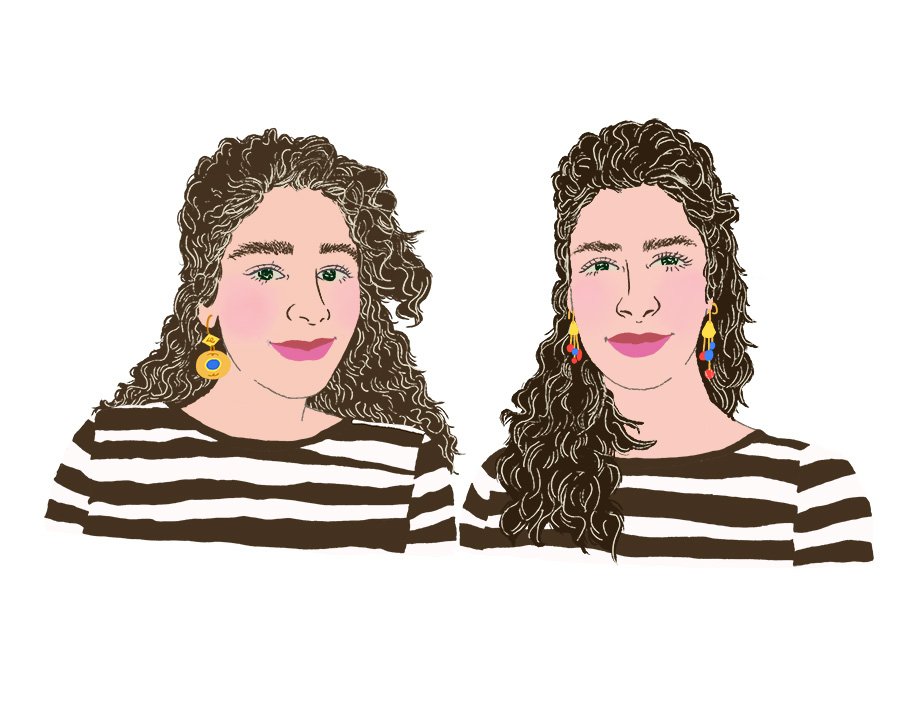Meet the Founders: How Our Work Led Us to Creating Thousand&One
We launched Thousand&One in May 2021. In this post, we’ll dive into who we are and how our work led us to creating this enterprise.
While the two of us have a lot in common, we also bring to this community distinct experiences in two different industries. Our shared journeys as marginalized women growing up in Toronto has shaped our discussions around identity, work, the world, and our place in it.
Illustration by Liu Liu
We both started out as humanities students, invested in the power of storytelling and understanding the importance of asking tough questions. From there, we went our separate ways: Hanieh began a career in tech and design, and Zahra, in research and academia.
We soon realized we had a similar vision – to challenge the status quo and create a more equitable world. And as minorities, we shared the same obstacles as we navigated two different industries. We’ve had decade-long chats about how we can turn our pain and anger into something productive that serves not just us, but others too. This led to us creating Thousand&One.
Below, we tell you how we arrived here, and how our work has informed and shaped our passion for creating a world where we can all thrive.
Meet Zahra
As a feminist film scholar, I have long felt the connection between the personal and the political. Even before I had the language to describe the intricate link between the two, I knew that my sense of self would spill into my work.
Academia became a double-edged sword for me. It exposed me to a host of painful experiences of marginalization, systemic racism, and sexism, but it also became the very space where I learned to challenge these structures.
The power and strength of storytelling is at the heart of my work. I am interested in who gets to be part of these stories, and who is left out. And it is through this framework, that I have been inspired to co-found Thousand&One.
Zahra Khosroshahi, Researcher and Lecturer
“Academia became a double-edged sword for me. It exposed me to a host of painful experiences of marginalization, systemic racism, and sexism, but it also became the very space where I learned to challenge these structures.”
Thousand&One is where I want to reshape and retell stories as a woman of colour. It is where I explore the intersections of my identities, as well as the personal and political. It didn’t take long for me to realize that my personal experiences of marginalization would bleed into how I felt in professional settings. What became even more apparent was the impact of our education system in reproducing these sets of ideas, and I knew that my role as an educator would be important in disrupting what we know to be ‘normal’ and standard.
In this paradoxical space of academia, I was able to find my purpose – my anger with systems that don't serve many of us, and my passion to dismantle them. Thousand&One for me represents my aspiration to seek changes that go beyond me and my industry.
Meet Hanieh
I have always been drawn to creative fields. My first exposure and interest came through the written word, and before getting into design, I explored photography and multimedia journalism. My work over the years has always been framed around one central question: how can I create impact? I am dedicated to challenging the status quo and ensuring that what we design today is done with intentionality, purpose, and ethics in mind.
Working in the tech industry as a woman of colour exposed me to a lot of systemic discrimination that left me feeling inaequate, unwelcomed, and stifled. That said, it also taught me that everything in our environment is by design. Nothing is accidental.
Hanieh Khosroshahi, Designer and Writer
“I use a Human-Centred approach to create impactful solutions that fit the needs of underrepresented individuals and communities. I believe that design has the power to create change, and I intend to use it to do just that.”
Before starting Thousand&One, I reflected a great deal on how the world we live in today has been intentionally designed to fit the needs of a few. So what’s stopping us from redesigning it?
As a designer, I use a Human-Centred approach to create impactful solutions that fit the needs of underrepresented individuals and communities. I believe that design has the power to create change, and I intend to use it to do just that.
I believe design can shift mindsets and behaviours, challenge policies and systems, and create change and impact in creative and collaborative ways. I am on a mission to use design to create a community for women of colour, intentionally designing for them and with them in mind. This is why I created Thousand&One.
Coming up Next
We’ve all heard that creating healthy boundaries at work is important. While this is true, it’s a lot easier said than done. Next month, we’ll talk about practical ways to set boundaries as women of colour in order to preserve our mental wellbeing, and grow in our professional lives.




